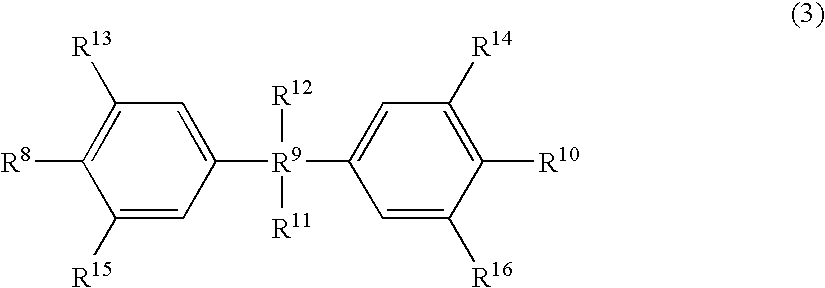Isolation material for hormone disrupting substance, method of concentrating and method of clean-up
a technology of endocrine disruptors and isolating materials, which is applied in the direction of weaving, other chemical processes, instruments, etc., can solve the problems of social problems, difficult to selectively and efficiently clean up those substances, and inability to increase the concentration rate beyond some extent by conventional methods, etc., to achieve efficient recovery, good recovery rate of 85%, and use efficient
- Summary
- Abstract
- Description
- Claims
- Application Information
AI Technical Summary
Benefits of technology
Problems solved by technology
Method used
Image
Examples
example 1
Preparation of Immunoaffinity Porous Hollow Fiber Membrane
[0131] In preparing an immunoaffinity porous hollow fiber membrane, the following materials were used. Also, the reagents used other than those shown below were of analytical grade or higher.
[0132] Carrier Substrate:
[0133] As the carrier substrate, a porous hollow fiber membrane of polyethylene (manufactured by Asahi Kasei Corporation) was used. The inside diameter and outside diameter of said hollow fiber were 1.8 mm and 3.1 mm, respectively. Also, said hollow fiber had a void ratio of 70%, and had formed a three-dimensional pore network with a pore diameter of 0.4 μm.
[0134] Reactive Monomer:
[0135] As the reactive monomer, glycidyl methacrylate (GMA, CH2═CCH3COOCH2CHOCH2) was obtained from Tokyo Kasei Co., Ltd., and used without further purification.
[0136] 17β-Estradiol (hereinafter also referred to as E2):
[0137] Obtained from Wako Pure Chemical Industries, Ltd.
example 2
(1) Binding of E2 to Immunoaffinity Porous Hollow Fiber Membrane
[0144] Various pieces of ES-IA (q) fiber (effective length 2.0 cm) having a ligand density (q) in the 3.1 to 5.8 mg / g-GMA fiber range were placed in the experimental apparatus, as shown in FIG. 2. Next, 1.0 μg / L of E2-containing 10% (v / v) methanol / water was passed to the membrane outer face through the pores from the membrane inner face of the ES-IA (q) fiber at room temperature and at a constant permeation rate in the 30 to 120 mL / hour range. The E2 concentration in the effluent passed to the membrane outer face of the ES-IA (q) fiber was continuously quantified using an estrogen (Estrogen; ES) ELISA kit (Takeda Chemical Industries, Ltd.). Changes in the E2 concentration in the effluent versus the volume of the effluent were plotted to obtain a breakthrough curve. Also, the equilibrated binding capacity (EBC) of E2 was calculated as shown in Formula (ii) below. EBC (µg / g)=∫0Ve(C0-C) ⅆV / W(ii)
[wherein C0 and C...
example 3
Recovery of E2 Using Hollow Fiber Membrane Estrogen Affinity Column
(1) Preparation of Affinity Column Using Hollow Fiber Membrane
[0148] A GMA hollow fiber membrane prepared by Example 1 was immersed in each of methanol and distilled water for 30 to 60 minutes. Next, the anti-estrogen antibody (2 mg / ml in 30 mM borate buffer solution (pH 10)) obtained in Reference Example 1 described below was added at 1 ml per 2 cm of the hollow fiber membrane, and reacted at 4° C. overnight. By washing the GMA membrane with the above-described borate buffer solution using a peristaltic pump, and measuring the amount of antibody in the washings, the amount of antibody bound to the membrane was calculated.
(2) Addition and Recovery of Estrogen Using Affinity Column
[0149] After the above-described affinity column was washed with 10 ml of PBS, an estrogen (17β-estradiol (E2) or estrone (E1)) dissolved in 10% methanol was applied to the prepared affinity column. After being washed with 10 ml of PBS...
PUM
| Property | Measurement | Unit |
|---|---|---|
| pore diameter | aaaaa | aaaaa |
| pore diameter | aaaaa | aaaaa |
| time | aaaaa | aaaaa |
Abstract
Description
Claims
Application Information
 Login to View More
Login to View More - R&D
- Intellectual Property
- Life Sciences
- Materials
- Tech Scout
- Unparalleled Data Quality
- Higher Quality Content
- 60% Fewer Hallucinations
Browse by: Latest US Patents, China's latest patents, Technical Efficacy Thesaurus, Application Domain, Technology Topic, Popular Technical Reports.
© 2025 PatSnap. All rights reserved.Legal|Privacy policy|Modern Slavery Act Transparency Statement|Sitemap|About US| Contact US: help@patsnap.com



